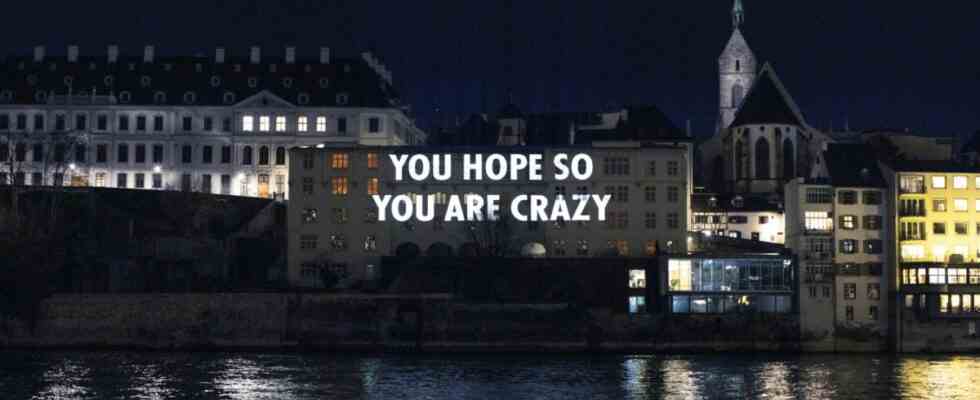The chunky infernal machine that currently stands in the basement of the Kunstmuseum Basel is formidable because of its sheer size. An iron piston painted jet black on rails moves slowly, humming softly and in a never-ending movement into and out of an equally black housing. The mechanical installation exudes violence under the surface, but also shows a certain sense of humour. “Twosome” is what Louise Bourgeois called her work from 1991. It sounds like a cross between a steam locomotive and a submarine. A red warning light rotates inside the object. Togetherness – an indefinable thing with a risk of injury?
The exhibition was curated by fellow American artist Jenny Holzer, born in 1950, who was friends with Bourgeois. It is rare that a world-famous artist tampers with the work of another world-famous artist in public, so to speak. Also because you can expect her to have less reservations, fewer scruples than a curator, an art historian or an exhibition organizer. The homage, which a retrospective can also be, becomes a confrontation.
Holzer once described her own art as “text in connection with light and its effect on people”. And although no art is shown by her, Holzer’s own affinity with language is just as noticeable as the willingness to take risks in dealing with the art of her older colleague, who for her part did not shy away from the intensity of her own emotional world.
First of all, it is noticeable that Holzer, contrary to all museum conventions, dispenses with captions and showcases. In this way she succeeds in snatching the art of Bourgeois from historicity for a brief moment and making it appear completely contemporary again. Holzer also distributed the works of Bourgeois throughout the museum like a trail, where in places they have the effect of feminist commentaries on art history. For example, one of the flagship works of the Basel collection, the lyrical, voluptuous Cézanne painting “Five Bathers” (1885/1887) in the permanent exhibition is challenged to a duel by a large bourgeois marble sculpture.
The elevator to the exhibition on the top floor of the museum seems to be haunted. A French nursery rhyme is sung. It is the voice of Bourgeois, which in her art kept returning to her childhood. “My childhood never lost its magical power, never lost its mysterious darkness, never lost its drama.” These scenes form the prologue for the real thing: a bourgeois show that unfolds as a psychologically intimate drama over nine gallery rooms with around 250 exhibits – scriptures, drawings, prints, paintings, sculptures and installations.
Smothered in the domestic: Louise Bourgeois’ “Femme maison”, 1982.
(Photo: Jonas Hänggi)
“The Violence of Handwriting Across a Page” is the title of this exhibition. Bourgeois was born in Paris in 1911 and moved to New York in 1938. She raised three children in her forties and fifties. Haunted by depression and insomnia, the artist produced works with a poetic directness and vulnerability that still gets under your skin today. Bourgeois, who died in New York in 2010 at the age of 98, became world famous with her large-scale spider sculptures and cell-like cage installations.
In Basel, Jenny Holzer is primarily presenting her drawings and writings. The artist’s works are installed in the museum up to the ceiling, sometimes in three rows one above the other. Their order does not follow chronology, but is based on certain thematic strands that run underground through the work, such as architecture and spaces, water and blood, family, love and sexuality, the body, birth and death.
There is, for example, the nine-part text-image cycle “He Disappeared into Complete Silence”, which was published in a small number of books in 1947 and now marks the start of the show. Bourgeois combined short texts, in which a high-spirited man is beheaded by an elevator, with etchings of constructions and spatial situations that appear no less nightmarish. Small sculptures can be seen on small shelves below, which aim at the gender-specific dimensions of the domestic. The theme of the “Femme Maison”, the female figure that has grown together with the house, often appears as a basic motif in Bourgeois’ work. Sometimes architectures appear as places of refuge, sometimes they turn out to be traps. The artist found simple and impressive images for the felt suffocation in the home: For example, only the legs, arms and hair of a Barbie doll peek out of a long, earth-colored lump.
The curator and artist Jenny Holzer in the Kunstmuseum Basel.
(Photo: Xandra M. Linsin)
For the many voices and stories that make up Louise Bourgeois’ autobiographical art, Holzer has staged a series of rooms in Basel that sometimes leave you amazed and sometimes shivering. But this art does not leave you indifferent.
Until May 15, Kunstmuseum Basel, publication accompanying the exhibition: The Violence of Handwriting Across a Page, JRP Editions, approx. 65 euros.

